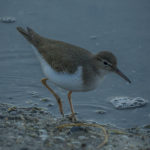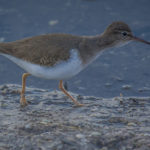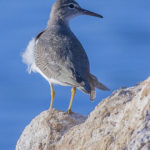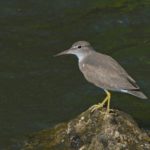October’s Bird of the Month is the Spotted Sandpiper, and here is the article in the October Kite written by Ben Kolstad.
“The lone North American representative of a two-bird genus, Actitis macularius is the most widespread sandpiper on the continent. (Its congener, A. hypoleucos, is a Eurasian bird.) Despite their near ubiquity according to the range maps, Spotted Sandpipers are not found everywhere in all seasons. Here in Palm Beach County, they are winter residents, and they eschew their namesake spots when they’re down here (field guides describe SPSA as “unmistakable” in breeding plumage).
There is one field mark, though, that, when you can spot it, clinches the ID of the winter-plumaged Spotted Sandpiper: a little white “check” on the shoulder. (This might remind you of the white “handkerchief” of the Black-throated Blue Warbler’s wing, although it’s in a different position with respect to the wing.) When seen well in good light, this field mark makes this nondescript winter-plumaged bird relatively easy to identify.
If you can’t see the white mark on the shoulder (perhaps the light is behind it so you have only a silhouette, or perhaps it’s in the shadows of a pond hammock), look for the body movements it displays while feeding, walking, or otherwise remaining “still”: if its tail teeters or its whole body bobs, you’ve spotted a spotted; if only its head nods, odds are it’s a solitary.
If you’re like me and you don’t notice the bird until you’ve gotten too close and flushed it, all is not lost! Watch how it flies away from you. Spotty has a characteristic flight pattern that can still clinch an ID for you: it almost always flies low to the water, wings held stiffly and (usually) below the horizontal. These “shallow, flicking” wingbeats make it look as if it’s always looking for a spot (pardon the pun) to land.”
(Photographer’s please note that next month’s November 2016 Bird will be the Kildeer)
- Spotted Sandpiper at Ding Darling NWR by Paul Thomas
- Spotted Sandpiper at Ding Darling NWR by Paul Thomas
- Spotted Sandpiper at Jupiter by Paul Thomas
- spotted sandpiper at Ding Darling by Anne DuPont
- Spotted Sandpiper at Ding Darling by Anne DuPont
- Spotted Sandpiper at Snook Island, Lake Worth by Anne DuPont







Comments are closed